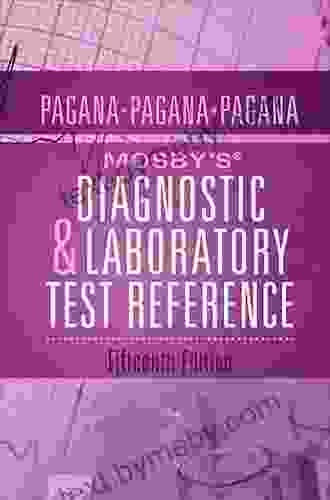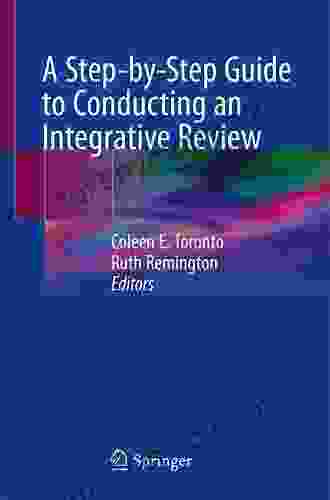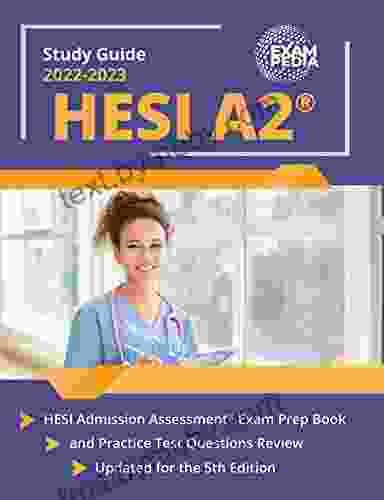Step-by-Step Guide to Conducting an Integrative Review: A Comprehensive Guide for Researchers

An integrative review is a research method that synthesizes findings from multiple studies to provide a more comprehensive understanding of a topic. It is a valuable tool for researchers who want to gain a deeper understanding of a complex issue or to identify gaps in the literature.
4.5 out of 5
| Language | : | English |
| File size | : | 3939 KB |
| Text-to-Speech | : | Enabled |
| Screen Reader | : | Supported |
| Enhanced typesetting | : | Enabled |
| Print length | : | 191 pages |
In this article, we will provide a step-by-step guide to conducting an integrative review. We will cover the following topics:
- What is an integrative review?
- When should you conduct an integrative review?
- How to conduct an integrative review
- Writing an integrative review
- Tips for conducting an integrative review
- Benefits of conducting an integrative review
- Challenges of conducting an integrative review
What is an integrative review?
An integrative review is a research method that synthesizes findings from multiple studies to provide a more comprehensive understanding of a topic. It is a valuable tool for researchers who want to gain a deeper understanding of a complex issue or to identify gaps in the literature.
Integrative reviews are different from traditional literature reviews in several ways. First, integrative reviews are more comprehensive than traditional literature reviews. They typically include a larger number of studies and they examine a wider range of issues. Second, integrative reviews are more analytical than traditional literature reviews. They go beyond simply summarizing the findings of individual studies. Instead, they synthesize the findings of multiple studies to provide a more comprehensive understanding of the topic.
When should you conduct an integrative review?
An integrative review is a good choice when you want to:
- Gain a deeper understanding of a complex issue
- Identify gaps in the literature
- Develop new theories or models
- Inform policy or practice
How to conduct an integrative review
The following are the steps involved in conducting an integrative review:
- Define your research question. The first step in conducting an integrative review is to define your research question. This will help you to focus your search for studies and to determine the scope of your review.
- Search for studies. Once you have defined your research question, you need to search for studies that are relevant to your topic. There are a number of different ways to search for studies, including using databases, searching the internet, and hand-searching journals.
- Screen studies. Once you have found a number of studies that are relevant to your topic, you need to screen them to determine which ones to include in your review. You should screen studies based on their relevance to your research question, their quality, and their methodological rigor.
- Extract data. Once you have selected the studies that you will include in your review, you need to extract data from them. The data that you extract will depend on the nature of your research question. However, you should typically extract data on the study's design, methods, results, and s.
- Analyze data. Once you have extracted data from the studies that you have included in your review, you need to analyze the data. The way that you analyze the data will depend on the nature of your research question. However, you should typically use a combination of quantitative and qualitative methods to analyze the data.
- Write your review. Once you have analyzed the data, you need to write your review. Your review should be organized around your research question and it should provide a comprehensive overview of the findings of the studies that you included in your review.
Writing an integrative review
The following are some tips for writing an integrative review:
- Start with a strong . Your should provide an overview of your research question and the purpose of your review. It should also provide a brief overview of the studies that you included in your review.
- Organize your review around your research question. The body of your review should be organized around your research question. Each section of your review should address a different aspect of your research question.
- Provide a comprehensive overview of the findings of the studies that you included in your review. In the body of your review, you should provide a comprehensive overview of the findings of the studies that you included in your review. You should discuss the strengths and weaknesses of each study and you should highlight any important findings.
- Conclude your review with a summary of your findings and a discussion of the implications of your findings. In the of your review, you should summarize your findings and discuss the implications of your findings. You should also identify any gaps in the literature and suggest directions for future research.
Tips for conducting an integrative review
The following are some tips for conducting an integrative review:
- Be systematic in your approach. When conducting an integrative review, it is important to be systematic in your approach. This will help you to ensure that you are comprehensive and that you do not miss any important studies.
- Use a variety of search methods. When searching for studies, it is important to use a variety of search methods. This will help you to ensure that you find all of the relevant studies.
- Be critical of the studies that you include in your review. When screening studies, it is important to be critical of the studies that you include in your review. You should only include studies that are relevant to your research question, that are of good quality, and that are methodologically sound.
- Use a variety of methods to analyze the data. When analyzing the data, it is important to use a variety of methods. This will help you to ensure that you get a comprehensive understanding of the data.
Benefits of conducting an integrative review
There are a number of benefits to conducting an integrative review:
- Integrative reviews can provide a more comprehensive understanding of a topic than traditional literature reviews.
- Integrative reviews can help to identify gaps in the literature.
- Integrative reviews can help to develop new theories or models.
- Integrative reviews can inform policy or practice.
Challenges of conducting an integrative review
There are also some challenges to conducting an integrative review:
- Integrative reviews can be time-consuming and labor-intensive.
- Integrative reviews can be difficult to conduct if the literature on a topic is limited or of poor quality.
- Integrative reviews can be difficult to write, especially if the findings of the studies that you included in your review are conflicting.
Integrative reviews are a valuable research method for researchers who want to gain a deeper understanding of a complex issue or to identify gaps in the literature. By following the steps outlined in this article, you can conduct an integrative review that is comprehensive, analytical, and informative.
4.5 out of 5
| Language | : | English |
| File size | : | 3939 KB |
| Text-to-Speech | : | Enabled |
| Screen Reader | : | Supported |
| Enhanced typesetting | : | Enabled |
| Print length | : | 191 pages |
Do you want to contribute by writing guest posts on this blog?
Please contact us and send us a resume of previous articles that you have written.
 Book
Book Novel
Novel Page
Page Chapter
Chapter Text
Text Story
Story Genre
Genre Reader
Reader Library
Library Paperback
Paperback E-book
E-book Magazine
Magazine Newspaper
Newspaper Paragraph
Paragraph Sentence
Sentence Bookmark
Bookmark Shelf
Shelf Glossary
Glossary Bibliography
Bibliography Foreword
Foreword Preface
Preface Synopsis
Synopsis Annotation
Annotation Footnote
Footnote Manuscript
Manuscript Scroll
Scroll Codex
Codex Tome
Tome Bestseller
Bestseller Classics
Classics Library card
Library card Narrative
Narrative Biography
Biography Autobiography
Autobiography Memoir
Memoir Reference
Reference Encyclopedia
Encyclopedia Rkia Elaroui Cornell
Rkia Elaroui Cornell Peter Green
Peter Green Mariusz Krukowski
Mariusz Krukowski Marc Evan Aupiais
Marc Evan Aupiais Lynn Palm
Lynn Palm Maria Hannay
Maria Hannay Wendy Wang
Wendy Wang Lisa Knopp
Lisa Knopp Richard H Coop
Richard H Coop Mark Chang
Mark Chang Michael Portis
Michael Portis Wayne Mardle
Wayne Mardle Russell Harris
Russell Harris Sarah Prager
Sarah Prager Varg Freeborn
Varg Freeborn William J Byrnes
William J Byrnes Luke Stoffel
Luke Stoffel Maia Motley
Maia Motley Yossef Bodansky
Yossef Bodansky Lisa Ohlen Harris
Lisa Ohlen Harris
Light bulbAdvertise smarter! Our strategic ad space ensures maximum exposure. Reserve your spot today!
 Zachary CoxFollow ·11.5k
Zachary CoxFollow ·11.5k Galen PowellFollow ·7.7k
Galen PowellFollow ·7.7k Chase SimmonsFollow ·6.8k
Chase SimmonsFollow ·6.8k Milton BellFollow ·5.3k
Milton BellFollow ·5.3k Frank ButlerFollow ·11.8k
Frank ButlerFollow ·11.8k Rubén DaríoFollow ·17.7k
Rubén DaríoFollow ·17.7k Aaron BrooksFollow ·4.4k
Aaron BrooksFollow ·4.4k Gabriel BlairFollow ·14k
Gabriel BlairFollow ·14k

 Clay Powell
Clay Powell20 Must Visit Attractions In La Paz, Bolivia
La Paz, Bolivia...

 Giovanni Mitchell
Giovanni MitchellUltimate Guide to Special Forces Skills, Tactics, and...
The world of...

 Joseph Heller
Joseph HellerThe Texas Ranger and Hunter Illustrated: A Visual Journey...
Prepare to embark on an...

 José Martí
José MartíThe Secrets and Science of Ads That Sell More: A...
Are you struggling to create...

 Eli Blair
Eli BlairAdolescents and Their Families: A Comprehensive Guide for...
Adolescence,...

 Neil Gaiman
Neil GaimanMosby Diagnostic and Laboratory Test Reference: The...
In the dynamic healthcare landscape, staying...
4.5 out of 5
| Language | : | English |
| File size | : | 3939 KB |
| Text-to-Speech | : | Enabled |
| Screen Reader | : | Supported |
| Enhanced typesetting | : | Enabled |
| Print length | : | 191 pages |












